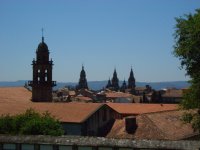Santiago de Compostela: Part III
 Our weekend in Santiago de Compostela was littered with charm. We slept in the attic room of the Hotel As Artes and had a view of a Cathedral spire through our skylight-window. In the morning, we woke up to music from church bells and bagpipes. We had our café con leche and breakfast of tarte de Santiago at the Café Literarios, on a plaza nestled between the Cathedral and a monastery-turned-convent. Bar-covered windows dotted the wide, plain wall of the convent. Some of the bars had rose vines entwined around them, so I think these windows indicated the rooms where the nuns live and sleep. Vagrants loitered and slept on the steps near the Cathedral during the shady hours of the afternoon; they looked like they should be on La Rambla in Barcelona. But they were harmless, part of the town’s interesting mix of tourists, pilgrims, and locals, passing the time with devil sticks, idle chat, and bongo drums.
Our weekend in Santiago de Compostela was littered with charm. We slept in the attic room of the Hotel As Artes and had a view of a Cathedral spire through our skylight-window. In the morning, we woke up to music from church bells and bagpipes. We had our café con leche and breakfast of tarte de Santiago at the Café Literarios, on a plaza nestled between the Cathedral and a monastery-turned-convent. Bar-covered windows dotted the wide, plain wall of the convent. Some of the bars had rose vines entwined around them, so I think these windows indicated the rooms where the nuns live and sleep. Vagrants loitered and slept on the steps near the Cathedral during the shady hours of the afternoon; they looked like they should be on La Rambla in Barcelona. But they were harmless, part of the town’s interesting mix of tourists, pilgrims, and locals, passing the time with devil sticks, idle chat, and bongo drums.Lunch was caldo gallega, a soup made of cabbage and potatoes, and Galician empanada, a kind of pastry stuffed with fish or meat. Dinner, eaten late since the light didn’t leak from the city until nearly ten, was, one night, tablas of cured meats and local cheeses; the second nig
 ht was our mariscada de casa. One afternoon, we went to hear the nuns singing Benedictine chants the monastery chapel. The next, we wandered into a park in the hills of the city, lost among lush green grass and trees. Churches were everywhere in town, the dark dampness inside a shock after the hot, bright sunlight.
ht was our mariscada de casa. One afternoon, we went to hear the nuns singing Benedictine chants the monastery chapel. The next, we wandered into a park in the hills of the city, lost among lush green grass and trees. Churches were everywhere in town, the dark dampness inside a shock after the hot, bright sunlight.Santiago de Compostela is a town to go back to. It offered such immense, intense enjoyment—while at the same time opening up new possibilities for other trips, other places. Galicia is a region I want to explore; and this is just one of many other parts of Spain I’ve yet to see. Maybe one day we really will go on the pilgrim trail, soaking all of it in, step after step, mile after mile.
Comments